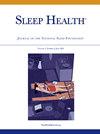Profiles of community support and challenges associated with insomnia symptoms: Findings from the pilot Bhutanese Community of Central Ohio Health Study
IF 3.4
2区 医学
Q2 CLINICAL NEUROLOGY
引用次数: 0
Abstract
Study objectives
We investigated profiles of community support and challenges in relation to insomnia symptoms among the Bhutanese living in the United States.
Methods
Using data from the pilot Bhutanese Community of Central Ohio Health Study (N = 495; 51.5% men, 69.8% aged 18-44 years), we used latent class analysis to identify distinct profiles of neighborhood social cohesion, social support, and community challenges (e.g., limited access to healthcare services and transportation, crime and safety issues, substance use, intimate partner violence) and their associations with insomnia symptoms. Insomnia symptoms were self-reported as difficulty falling and staying asleep and dichotomized as “not at all” vs. “some to always.” Identified classes/profiles were further differentiated by self-reported sociodemographic, socioeconomic, health, acculturative, and discrimination factors.
Results
Latent class analysis revealed four distinct classes/profiles. The High Cohesion (class 1) profile (30.1% of sample) had the lowest likelihood of insomnia symptoms at 6.5%, followed by class 2 or High Support (23.6%) with a 15.3% likelihood. Class 3 or High Challenges profile (11.5%) had a moderate likelihood of insomnia symptoms at 49%. Class 4 or the Low Cohesion/Support profile (34.7%) had a 100% likelihood of reporting insomnia symptoms. Class 4 when compared to class 1 was more likely to report cardiometabolic conditions, experiences of everyday discrimination, limited English linguistic proficiency, and not using telehealth.
Conclusion
Community social cohesion and support may play an important role in mitigating insomnia symptoms among Bhutanese refugees. Further investigations are warranted.
与失眠症状相关的社区支持和挑战概况:俄亥俄州中部不丹人社区试点健康研究的结果。
研究目的我们调查了居住在美国的不丹人中与失眠症状相关的社区支持和挑战的概况:利用俄亥俄州中部不丹人社区健康研究试点项目(N = 495;51.5%为男性,69.8%年龄在18-44岁之间)的数据,我们采用潜类分析法确定了邻里社会凝聚力、社会支持和社区挑战(如获得医疗服务和交通的途径有限、犯罪和安全问题、药物使用、亲密伴侣暴力)的不同特征及其与失眠症状的关联。失眠症状被自我报告为入睡和保持睡眠困难,并被二分为 "完全没有 "与 "一些到总是有"。根据自我报告的社会人口、社会经济、健康、文化和歧视因素,对确定的类别/特征进行了进一步区分:潜类分析显示出四个不同的类别/特征。高凝聚力(1 类)特征(占样本的 30.1%)出现失眠症状的可能性最低,仅为 6.5%,其次是 2 类或高支持(23.6%)特征,出现失眠症状的可能性为 15.3%。第 3 类或高挑战(11.5%)出现失眠症状的可能性为 49%,属于中等水平。第 4 类或低凝聚力/低支持度(34.7%)报告失眠症状的可能性为 100%。第 4 类与第 1 类相比,更有可能报告心脏代谢疾病、日常歧视经历、英语语言能力有限以及不使用远程医疗:结论:社区的社会凝聚力和支持可能在减轻不丹难民的失眠症状方面发挥重要作用。有必要开展进一步调查。
本文章由计算机程序翻译,如有差异,请以英文原文为准。
求助全文
约1分钟内获得全文
求助全文
来源期刊

Sleep Health
CLINICAL NEUROLOGY-
CiteScore
6.30
自引率
9.80%
发文量
114
审稿时长
54 days
期刊介绍:
Sleep Health Journal of the National Sleep Foundation is a multidisciplinary journal that explores sleep''s role in population health and elucidates the social science perspective on sleep and health. Aligned with the National Sleep Foundation''s global authoritative, evidence-based voice for sleep health, the journal serves as the foremost publication for manuscripts that advance the sleep health of all members of society.The scope of the journal extends across diverse sleep-related fields, including anthropology, education, health services research, human development, international health, law, mental health, nursing, nutrition, psychology, public health, public policy, fatigue management, transportation, social work, and sociology. The journal welcomes original research articles, review articles, brief reports, special articles, letters to the editor, editorials, and commentaries.
 求助内容:
求助内容: 应助结果提醒方式:
应助结果提醒方式:


